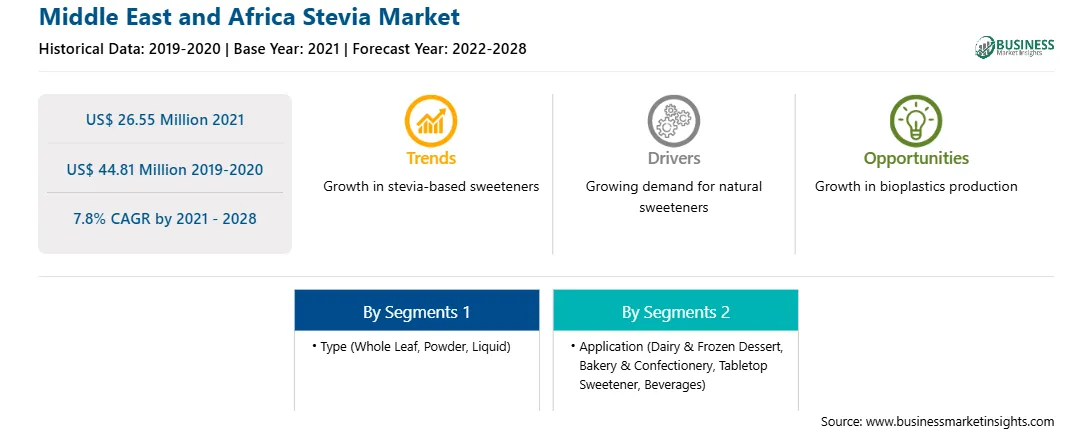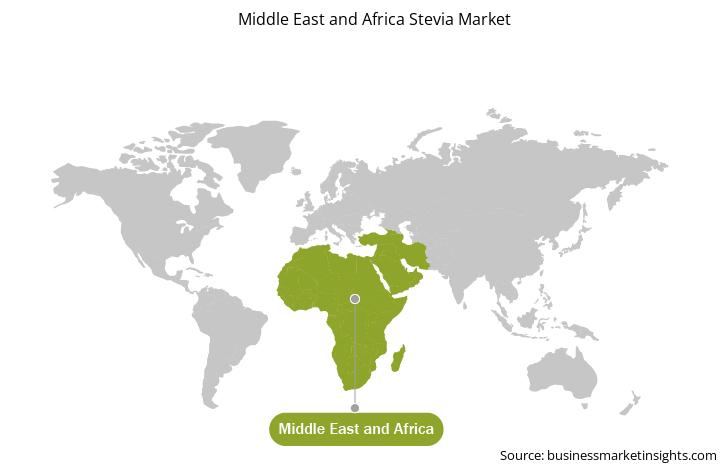中东和非洲甜菊市场预测至 2028 年 - COVID-19 影响和按类型(全叶、粉末和液体)、应用(乳制品和冷冻甜点、面包和糖果、桌面甜味剂、饮料等)进行的区域分析
No. of Pages: 93 | Report Code: TIPRE00024951 | Category: Food and Beverages
No. of Pages: 93 | Report Code: TIPRE00024951 | Category: Food and Beverages
中东和非洲甜菊市场是一个高度分散的市场,存在大量区域和本地参与者为投资市场的公司提供众多解决方案。随着糖尿病和肥胖症发病率的增加,消费者逐渐转向天然甜味产品。肥胖是一种普遍疾病,会导致糖尿病以及其他慢性疾病,如高血压、代谢综合征、心血管风险和视网膜病变。该地区当局正在关注更健康的生活方式,其中包括减少卡路里消耗量,尤其是添加糖。世界卫生组织(WHO)建议减少日常生活中添加糖的摄入。为了减少糖的摄入量,消费者更喜欢甜叶菊等天然甜味剂,它通过减少添加的糖和热量来帮助控制体重。与此同时,消费者越来越多地消费不添加糖的产品。因此,消费者对天然甜味剂倾向的增加正在推动甜叶菊市场的增长。
在中东和非洲,南非报告了大量的 COVID-19 病例案件,导致包括甜叶菊生产活动在内的多项业务停止。 2020 年初,其他食品和饮料生产行业的衰退对甜叶菊的需求产生了负面影响。然而,疫情是消费者偏好发生重大转变的一个原因,导致人们对健康生活方式的认识不断增强。由于大流行,消费者正在用更健康的替代品替代传统成分,这反过来又增加了对甜叶菊等天然甜味剂的需求。疫情期间,随着消费者无添加糖和低碳水化合物饮食趋势的增加,导致对甜叶菊的需求增加。在大流行期间,由于人们寻求改善整体健康和福祉的解决方案,对低糖和增强免疫力的产品的需求迅速激增。 COVID-19 大流行促使顾客提高健康意识并转向低热量或无糖食品。因此,由于新冠疫情大流行,中东和非洲人口的健康意识不断增强,对降糖解决方案的需求也越来越大,这对甜菊市场产生了积极影响。
中东和非洲甜菊市场预计将从2021年的2655万美元增长到2021年的4481万美元2028;预计 2021 年至 2028 年复合年增长率为 7.8%。该地区各国政府正在努力减少糖的摄入量。各个政府机构正在促进更健康的消费习惯。阿联酋、阿曼、沙特阿拉伯等国家已宣布对含糖饮料征收消费税。这些新税收有助于政府促进更健康的消费和预防与消费对人类健康有害的高糖特定产品有关的慢性疾病。 所有这些因素都创造了对甜叶菊的需求。 此外,该地区的运营商正在推出应用范围更广的产品。这些因素进一步推动了中东和非洲地区的市场增长。
按类型分,2020年中东和非洲甜菊市场份额最大的是粉末细分市场。按应用分,饮料细分市场占中东和非洲甜菊市场份额最大2020 年市场。
准备本报告时参考的一些主要一手和二手来源中东和非洲甜菊市场的信息包括公司网站、年报、财务报告、国家政府文件、统计数据库等。报告中列出的主要公司包括嘉吉公司(Cargill, Incorporated);安瑞安公司;泰特美术馆莱尔公司;阿彻-丹尼尔斯-米德兰公司; S&W 种子公司;和 PureCircle。
Strategic insights for Middle East and Africa Stevia involve closely monitoring industry trends, consumer behaviours, and competitor actions to identify opportunities for growth. By leveraging data analytics, businesses can anticipate market shifts and make informed decisions that align with evolving customer needs. Understanding these dynamics helps companies adjust their strategies proactively, enhance customer engagement, and strengthen their competitive edge. Building strong relationships with stakeholders and staying agile in response to changes ensures long-term success in any market.

| Report Attribute | Details |
|---|---|
| Market size in 2021 | US$ 26.55 Million |
| Market Size by 2028 | US$ 44.81 Million |
| Global CAGR (2021 - 2028) | 7.8% |
| Historical Data | 2019-2020 |
| Forecast period | 2022-2028 |
| Segments Covered |
By 类型
|
| Regions and Countries Covered | 中东和非洲
|
| Market leaders and key company profiles |
The regional scope of Middle East and Africa Stevia refers to the geographical area in which a business operates and competes. Understanding regional nuances, such as local consumer preferences, economic conditions, and regulatory environments, is crucial for tailoring strategies to specific markets. Businesses can expand their reach by identifying underserved regions or adapting their offerings to meet regional demands. A clear regional focus allows for more effective resource allocation, targeted marketing, and better positioning against local competitors, ultimately driving growth in those specific areas.

The Middle East and Africa Stevia Market is valued at US$ 26.55 Million in 2021, it is projected to reach US$ 44.81 Million by 2028.
As per our report Middle East and Africa Stevia Market, the market size is valued at US$ 26.55 Million in 2021, projecting it to reach US$ 44.81 Million by 2028. This translates to a CAGR of approximately 7.8% during the forecast period.
The Middle East and Africa Stevia Market report typically cover these key segments-
The historic period, base year, and forecast period can vary slightly depending on the specific market research report. However, for the Middle East and Africa Stevia Market report:
The Middle East and Africa Stevia Market is populated by several key players, each contributing to its growth and innovation. Some of the major players include:
The Middle East and Africa Stevia Market report is valuable for diverse stakeholders, including:
Essentially, anyone involved in or considering involvement in the Middle East and Africa Stevia Market value chain can benefit from the information contained in a comprehensive market report.